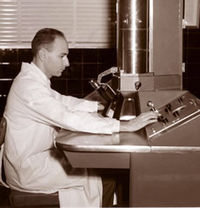Humberto Fernández Morán Scientist
Humberto Fernández-Morán Villalobos (February 18, 1924 – March 17, 1999) was a Venezuelan research scientist born in Maracaibo, Venezuela, renowned for inventing the diamond knife or scalpel, significantly advancing the development of electromagnetic lenses for electron microscopy based on superconducting technology, and many other scientific contributions. A quick review of his oft-cited peer-reviewed publications in journals of science shows a wide range of scientific research interests, from elucidating mitochondrial membrane structure to compositional analyses of lunar rock obtained in the course of NASA's Apollo missions.Dr. Fernández-Morán founded the Venezuelan Institute for Neurological and Brain Studies, the predecessor of the current Venezuelan Institute of Scientific Research (IVIC). He studied medicine at the University of Munich, where he graduated summa cum laude in 1944. He contributed to the development of the electron microscope and was the first person to use the concept of cryo-ultramicrotomy. After flying over Angel Falls in his home country of Venezuela he was inspired by the concept of the smoothly reoccurring flow system inherent in a waterfall to take his diamond knife invention and combine it with an ultramicrotome to dramatically improve the ultra-thin sectioning of electron microscopy samples. The ultramictrotome advances the rotating, drum-mounted specimen sample in such small increments (utilizing the very low thermal expansion coefficient of Invar) past the stationary diamond knife that sectioning thicknesses of several Angstrom units are possible. He also helped to advance the field of electron cryomicroscopy - the use of superconductive electromagnetic lenses cooled with liquid helium in electron microscopes to achieve the highest resolution possible - among many other research topics.He was appointed Minister of Science during the last year of the regime of Marcos Pérez Jiménez and was forced to leave Venezuela when the dictatorship was overthrown in 1958. He worked with NASA for the Apollo Project and taught in many universities, such as MIT, University of Chicago and the University of Stockholm.In the United States he was proposed to be nominated for the Nobel Prize. He rejected the nomination because he would have had to embrace American citizenship, which he refused, wanting to maintain his Venezuelan nationality.His wife Anna was Swedish and together they had two daughters, Brigida Elena and Veronica.The body of Dr. Humberto Fernández-Morán Villalobos was cremated and his ashes rest today in his second homeland, Stockholm, Sweden.He donated a collection of his papers to the National Library of Medicine in 1986.
